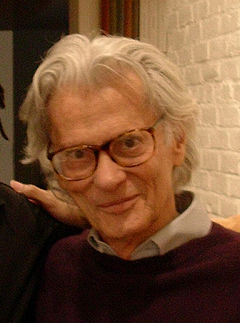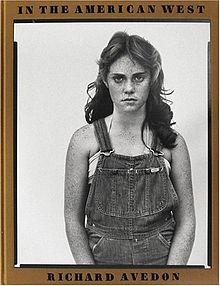Richard Avedon
| Richard Avedon | |
|---|---|
 Richard Avedon, 2004 |
|
| Born | May 15, 1923 New York, New York |
| Died | October 1, 2004 (aged 81) San Antonio, Texas |
| Occupation | Photographer |
Richard Avedon (May 15, 1923 – October 1, 2004) was an American photographer. An obituary published in The New York Times said that "his fashion and portrait photographs helped define America's image of style, beauty and culture for the last half-century."[1]
Contents |
[edit] Photography career
Avedon was born in New York City to a Jewish Russian family. He attended DeWitt Clinton High School in the Bronx, where he worked on the school paper with James Baldwin.[2] After briefly attending Columbia University, he started as a photographer for the Merchant Marines in 1942, taking identification pictures of the crewmen with his Rolleiflex camera given to him by his father as a going-away present. In 1944, he began working as an advertising photographer for a department store, but was quickly discovered by Alexey Brodovitch, the art director for the fashion magazine Harper's Bazaar. Lillian Bassman also promoted Avedon's career at Harper's.
In 1946, Avedon had set up his own studio and began providing images for magazines including Vogue and Life. He soon became the chief photographer for Harper's Bazaar. Avedon did not conform to the standard technique of taking fashion photographs, where models stood emotionless and seemingly indifferent to the camera. Instead, Avedon showed models full of emotion, smiling, laughing, and, many times, in action.
In 1966, Avedon left Harper's Bazaar to work as a staff photographer for Vogue magazine. He proceeded to become the lead photographer of Vogue and photographed most of the covers from 1973 until Anna Wintour became editor in chief in late 1988.[3][4] Notable among his fashion advertisement photograph series are the recurring assignments for Gianni Versace, starting from the spring/summer campaign 1980. He also photographed the Calvin Klein Jeans campaign featuring a fifteen year old Brooke Shields, as well as directing her in the television commercials. Avedon first worked with Shields in 1974 for a Colgate toothpaste ad. He shot her for Versace, 12 American Vogue covers and Revlon's Most Unforgettable Women campaign. In the February 9, 1981 issue of Newsweek, Avedon said that "Brooke is a lightning rod. She focuses the inarticulate rage people feel about the decline in contemporary morality and destruction of innocence in the world." On working with Avedon, Shields told Interview magazine in May 1992 "When Dick walks into the room, a lot of people are intimidated. But when he works, he's so acutely creative, so sensitive. And he doesn't like it if anyone else is around or speaking. There is a mutual vulnerability, and a moment of fusion when he clicks the shutter. You either get it or you don't".
In addition to his continuing fashion work, Avedon began to branch out and photographed patients of mental hospitals, the Civil Rights Movement in 1963, protesters of the Vietnam War, and later the fall of the Berlin Wall. During this period, Avedon also created two famous sets of portraits of The Beatles. The first, taken in mid to late 1967, became one of the first major rock poster series, and consisted of five striking psychedelic portraits of the group — four heavily solarized individual color portraits (solarisation of prints by his assistant, Gideon Lewin, retouching by Bob Bishop) and a black-and-white group portrait taken with a Rolleiflex camera and a normal Planar lens. The next year he photographed the much more restrained portraits that were included with The Beatles in 1968. Among the many other rock bands photographed by Avedon, in 1973 he shot Electric Light Orchestra with all the members exposing their bellybuttons for recording, On the Third Day.
Avedon was always interested in how portraiture captures the personality and soul of its subject. As his reputation as a photographer became widely known, he brought in many famous faces to his studio and photographed them with a large-format 8x10 view camera. His portraits are easily distinguished by their minimalist style, where the person is looking squarely in the camera, posed in front of a sheer white background. Avedon would at times evoke reactions from his portrait subjects by guiding them into uncomfortable areas of discussion or asking them psychologically probing questions. Through these means he would produce images revealing aspects of his subject's character and personality that were not typically captured by others.[5]
He is also distinguished by his large prints, sometimes measuring over three feet in height. His large-format portrait work of drifters, miners, cowboys and others from the western United States became a best-selling book and traveling exhibit entitled In the American West, and is regarded as an important hallmark in 20th century portrait photography, and by some as Avedon's magnum opus. Commissioned by the Amon Carter Museum in Fort Worth, Texas, it was a six-year project Avedon embarked on in 1979, that produced 125 portraits of people in the American west who caught Avedon's eye.
Avedon was drawn to working people such as miners and oil field workers in their soiled work clothes, unemployed drifters, and teenagers growing up in the West circa 1979-84. When first published and exhibited, In the American West was criticized for showing what some considered to be a disparaging view of America. Avedon was also lauded for treating his subjects with the attention and dignity usually reserved for the politically powerful and celebrities. Laura Wilson served as Avedon's assistant during the creation of In the American West and in 2003 published a photo book documenting the experiences, Avedon at Work, In the American West.
Avedon became the first staff photographer for The New Yorker in 1992.[6] He has won many awards for his photography, including the International Center of Photography Master of Photography Award in 1993, the Prix Nadar in 1994 for his photobook Evidence, and the Royal Photographic Society 150th Anniversary Medal in 2003. He was elected a Fellow of the American Academy of Arts and Sciences in 2001.[7]
Avedon had numerous museum exhibitions around the world, including The Metropolitan Museum of Art, the Whitney Museum of Art in New York, the Guggenheim Museum Bilbao in Spain, and the Museum of Fine Arts, Boston.
[edit] Personal life
In 1944, Avedon married Dorcas Nowell, who later became a model and was known professionally as Doe Avedon. Nowell and Avedon divorced after five years of marriage. In 1951, he married Evelyn Franklin; she died on March 13, 2004.[8] Their marriage produced one son, John Avedon, an author and authority on Tibet.[9][10]
Martial arts movie star Loren Avedon is the nephew of Richard Avedon.
On October 1, 2004, Avedon died of a brain hemorrhage in San Antonio, Texas, while shooting an assignment for The New Yorker. At the time of his death, he was also working on a new project titled Democracy to focus on the run-up to the 2004 U.S. presidential election.
Avedon is survived by his son John, and his four grandchildren William, Matthew, Michael and Caroline.
[edit] Funny Face
Hollywood presented a fictional account of his early career in the 1957 musical Funny Face, starring Fred Astaire as the fashion photographer "Dick Avery." Avedon supplied some of the still photographs used in the production, including its most famous single image: an intentionally overexposed close-up of Audrey Hepburn's face in which only her famous features - her eyes, her eyebrows, and her mouth - are visible.
Hepburn was Avedon's muse in the 1950s and 1960s, and he went so far as to say "I am, and forever will be, devastated by the gift of Audrey Hepburn before my camera. I cannot lift her to greater heights. She is already there. I can only record. I cannot interpret her. There is no going further than who she is. She has achieved in herself her ultimate portrait."[11]
[edit] Famous photographs
- Marella Agnelli, Italian socialite, 1953
- Carmen Mayrink Veiga, Brazilian socialite (Vogue's 10 best dressed), 1970
- Dovima with Elephants, 1955
- Marilyn Monroe, actress, 1957
- Homage to Munkacsi, Carmen, coat by Cardin, Paris 1957
- Christina Bellin, model, 1962
- Dwight David Eisenhower, President of the United States, 1964
- The Beatles, 1967
- Andy Warhol and Members of the Factory, New York 1969
- Sly Stone (cover of Fresh Album), 1973
- Asha Puthli (She Loves to Hear the Music Album back cover), 1974
- Ronald Fischer, beekeeper, 1981
- Nastassja Kinski and the Serpent, 1981
- Pile of beautiful people, Versace campaign 1982.
[edit] Books by Richard Avedon
- Observations, 1959. A collaborative book with Truman Capote containing portraits of many famous people of the twentieth century, including Pablo Picasso, J. Robert Oppenheimer, and Mae West.
- Nothing Personal, 1964. A collaborative book with James Baldwin.
- Alice in Wonderland, 1973, co-authored with Doon Arbus.
- Portraits, 1976
- Portraits 1947-1977, 1978
- In the American West, 1985
- An Autobiography, 1993. Contains 50 years of images arranged to tell Avedon's life story. Photos include celebrities such as Marilyn Monroe, Judy Garland, Andy Warhol, and Avedon's parents.
- Evidence, 1994. More than 600 images encompassing Avedon's fashion photographs, portraiture, journalistic shots, sketches, snapshots, and contact sheets. However, despite containing many images, the book focuses more on the essays and text about Avedon instead of being fully based on visuals.
- The Sixties, 1999, co-authored with Doon Arbus. Contains images of many famous figures such as Janis Joplin, Jimi Hendrix, and Twiggy.
- Made in France, 2001. A retrospective of Avedon's fashion portraiture from the 1950s. The book is expensive due to the images being printed on tritone plates.
- Richard Avedon Portraits' 2002. 50 black and white images of celebrities and subjects from his In The American West project. Its release coincided with an exhibition of the work at the Metropolitan Museum of Art.
- Woman in the Mirror. 2005, with an essay by Anne Hollander.
- Performance. 2008, with an essay by John Lahr.
- Portraits of Power. 2008, edited by Paul Roth with an essay by Renata Adler. Coincides with an exhibition of political work at the Corcoran Gallery of Art in Washington DC.
[edit] References
- ^ Grundberg "Richard Avedon, the Eye of Fashion, Dies at 81. the New York Times, October 1, 2004
- ^ Staff. "Richard Avedon", The Daily Telegraph, October 2, 2004. Accessed September 14, 2009. "He also edited the school magazine at DeWitt Clinton High, on which the black American writer James Baldwin was literary editor."
- ^ Vogue July 1973
- ^ Vogue October 1988
- ^ PBS American Masters, Richard Avedon: Darkness and Light, Directed by Helen Whitney, 1995
- ^ Women's Wear Daily, October 2004.
- ^ "Book of Members, 1780-2010: Chapter A". American Academy of Arts and Sciences. http://www.amacad.org/publications/BookofMembers/ChapterA.pdf. Retrieved 27 April 2011.
- ^ "Paid Notice: Deaths AVEDON, EVELYN FRANKLIN". The New York Times. March 16, 2004. http://www.nytimes.com/2004/03/16/classified/paid-notice-deaths-avedon-evelyn-franklin.html.
- ^ The Buddha's Art of Healing: Tibetan Paintings Rediscovered, John Avedon, Rizzoli, 1998
- ^ Exploring the Mysteries of Tibetan Medicine, John Avedon, The New York Times Magazine, January 11, 1981.
- ^ Karney, Robyn. A Star Danced: The Life of Audrey Hepburn, Bloomsbury. London: 1993
[edit] External links
- Richard Avedon at Encyclopædia Britannica
- Richard Avedon at the Museum of Modern Art
- Richard Avedon at Find a Grave
- Official site
- Richard Avedon: Portrait Series of Jacob Israel Avedon from the Collection of The Jewish Museum (New York)
- AIGA Medalists
- Fashion photographers
- American photographers
- Commercial photographers
- Photographers from New York
- Columbia University alumni
- DeWitt Clinton High School alumni
- American people of Russian-Jewish descent
- People from New York City
- American Jews
- Portrait photographers
- 1923 births
- 2004 deaths
- Deaths from cerebral hemorrhage
- American sailors
- Fellows of the American Academy of Arts and Sciences
